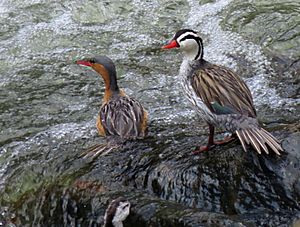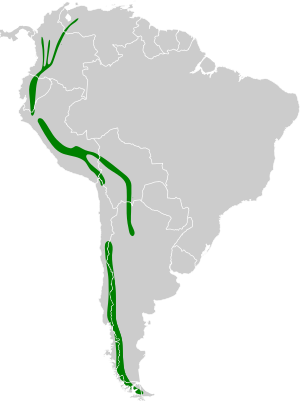Torrent duck facts for kids
The torrent duck (Merganetta armata) is a special type of duck that lives in the fast-flowing rivers of the Andes mountains in South America. It's the only duck in its group, called Merganetta. This duck is part of the larger duck, goose, and swan family known as Anatidae.
Quick facts for kids Torrent duck |
|
|---|---|
 |
|
| Female (left) and male Colombian torrent duck, Cañón del Río Anaime, Colombia | |
| Conservation status | |
| Scientific classification | |
| Genus: |
Merganetta
|
| Species: |
armata
|
| Subspecies | |
|
M. a. colombiana (Des Murs, 1845) |
|
 |
|
Contents
About the Torrent Duck
Torrent ducks are about 43 to 46 centimeters (about 17 to 18 inches) long. They make their homes in small caves or other safe spots near the water. They love fast-moving mountain rivers, usually high up, above 1,500 meters (about 4,900 feet).
How They Move
These ducks are amazing swimmers and divers. They can handle even very rough, white water! They don't like to fly long distances, usually only short flights when they need to. They are not very shy when people are around.
What They Look Like
- Males: Male torrent ducks have a cool black and white pattern on their heads and necks. They also have a bright red bill. When they fly, you can see their dark wings with a shiny green patch called a speculum.
- Females: Females are a bit smaller than the males. They have orange feathers on their bellies and throats. Their heads and upper bodies are grey, and their bills are more yellowish.
- Young Ducks: Baby torrent ducks (juveniles) are light grey on top and whitish underneath.
Their Calls
- The male torrent duck makes a high-pitched, shrill whistle.
- The female's call is a deeper, throatier whistle.
Why They Need Our Help
The number of torrent ducks is going down. This is happening for a few reasons:
- Competition: New types of trout fish have been put into the rivers. These trout eat the same invertebrate (bug) food that the ducks need.
- Pollution: Rivers are getting polluted, which harms the ducks and their food.
- Habitat Loss: Forests are being cut down, and dams are being built on mountain rivers to make electricity. This destroys the places where the ducks live and nest.
Even though their numbers are decreasing, there are still enough torrent ducks for them to be listed as a "Species of Least Concern" by the IUCN Redlist. This means they are not in immediate danger of disappearing, but we still need to protect them. The ducks in Chile seem to be doing okay, but those further north are having a harder time.
Subspecies of Torrent Ducks
There are different types, or subspecies, of torrent ducks, and it can be a bit tricky to tell them apart. Here are the main ones:
- Chilean Torrent Duck (M. a. armata): Males of this type have grey backs and blackish undersides, with a chestnut-colored belly. They are the only ones with a black "teardrop" mark under their eye.
- Colombian Torrent Duck (M. a. colombiana): These are a bit smaller than the Chilean ducks. Males have lighter, streaked grey-brown feathers underneath.
- Peruvian Torrent Duck (M. a. leucogenis): Males of this type are somewhere in between the other two, and their colors can vary a lot. Some even have completely black undersides. Sometimes, this type is divided into four smaller groups, but scientists think these are probably just different color variations rather than completely separate subspecies.
Images for kids
-
Juvenile (left) and female Peruvian torrent duck on the Urubamba River, Peru
-
Male Chilean torrent duck near Fitz Roy, Argentina
See also

- In Spanish: Pato de los torrentes para niños







